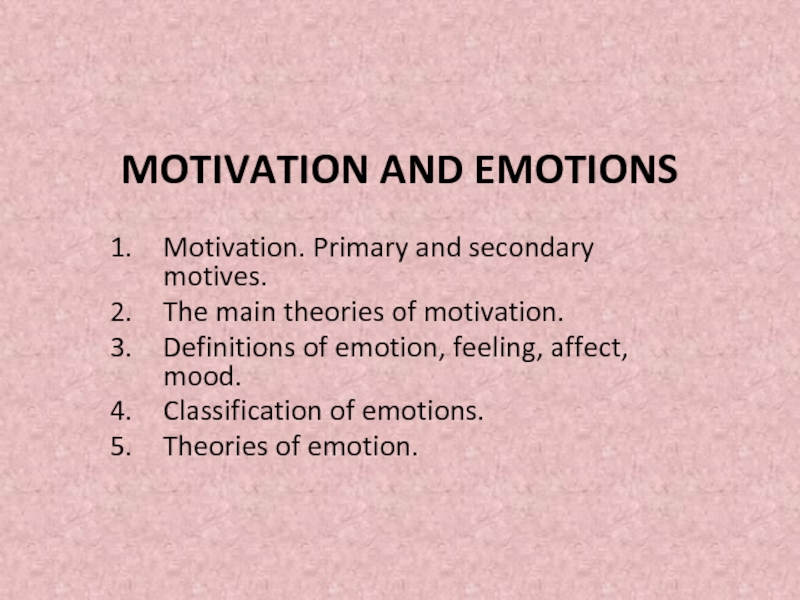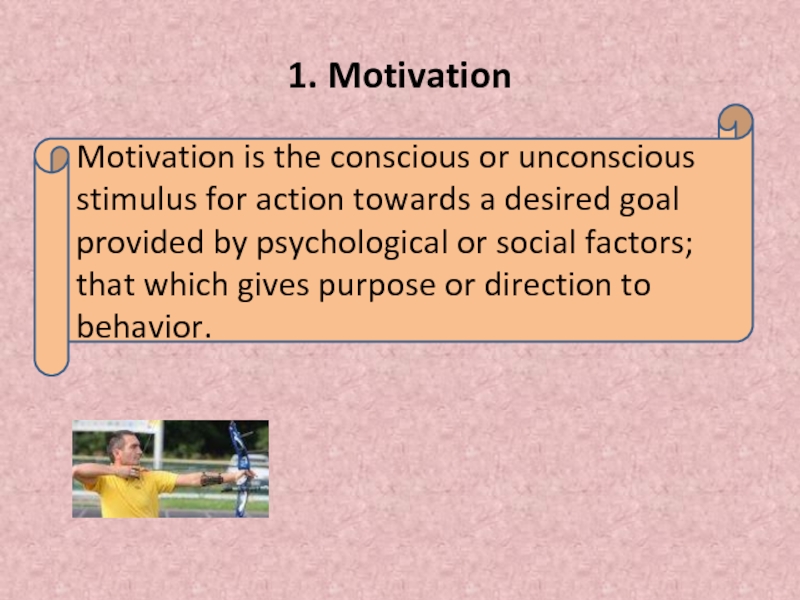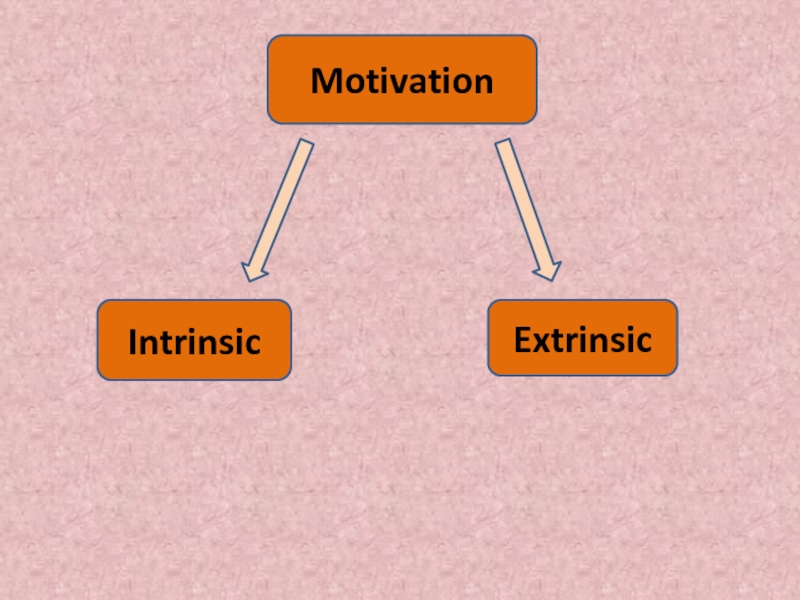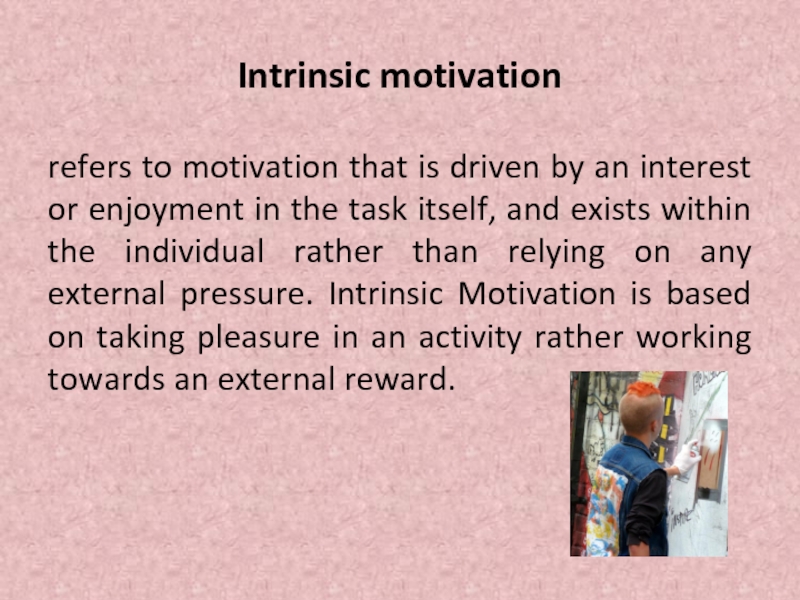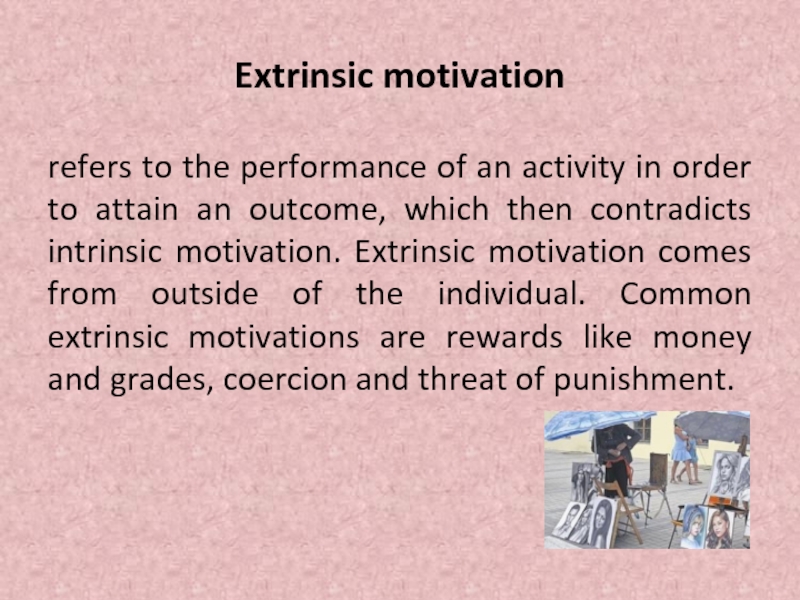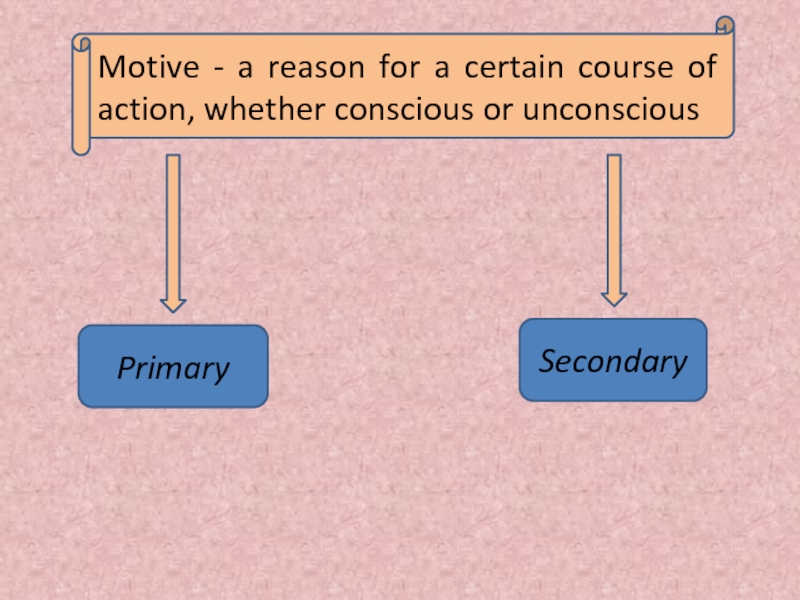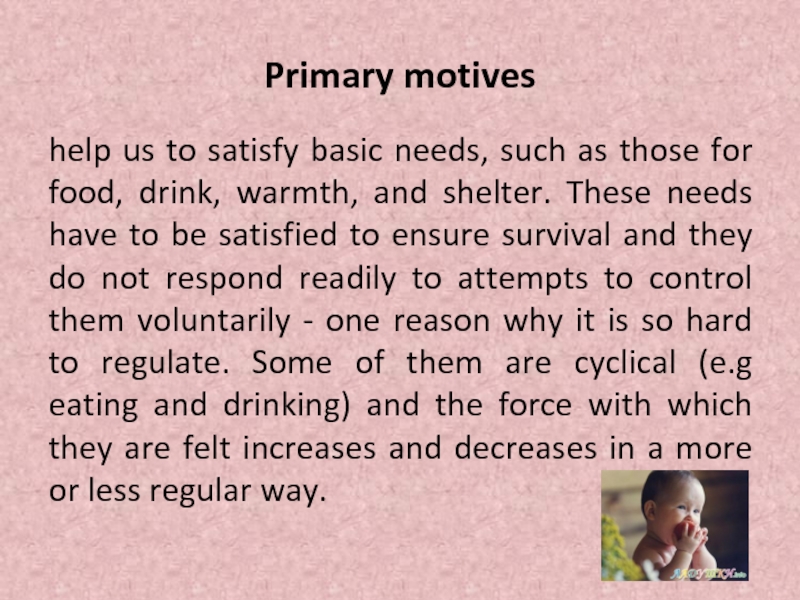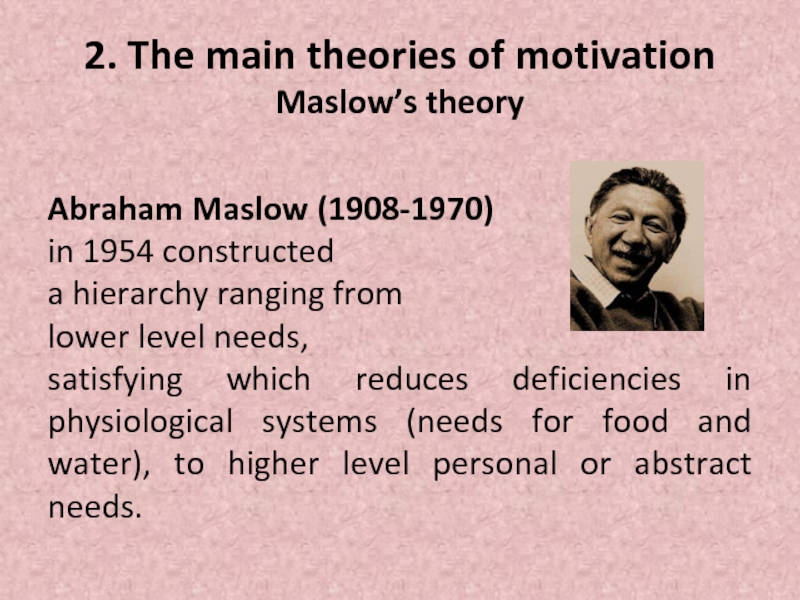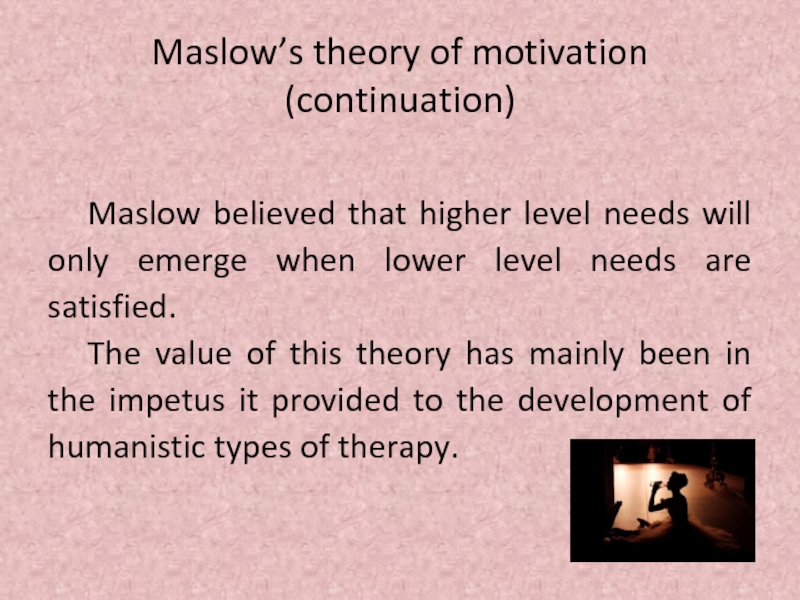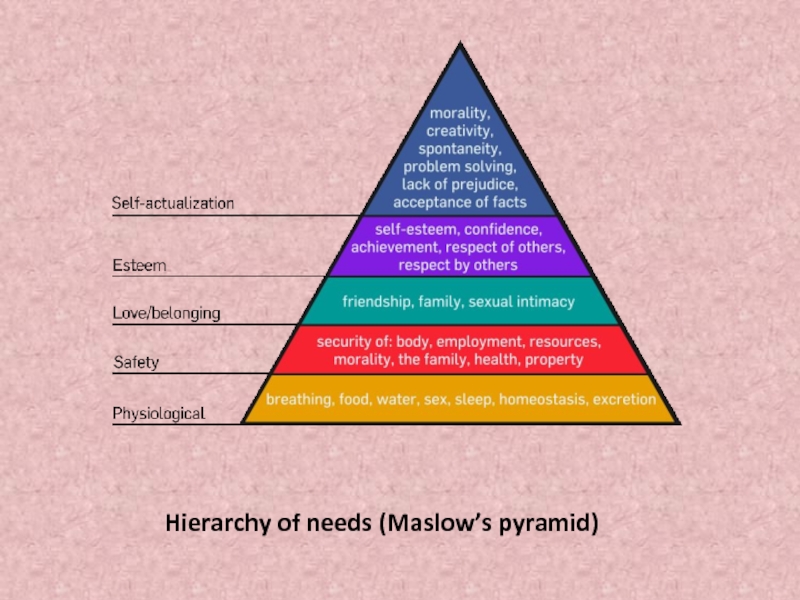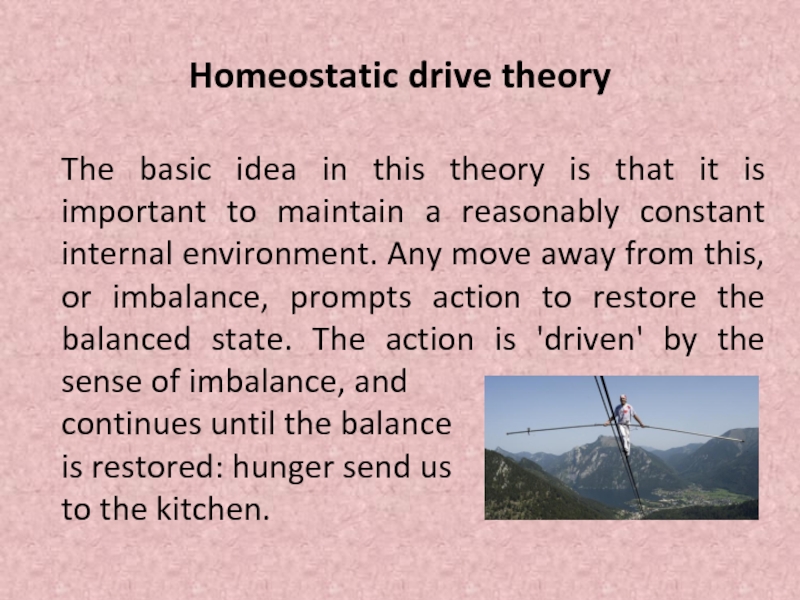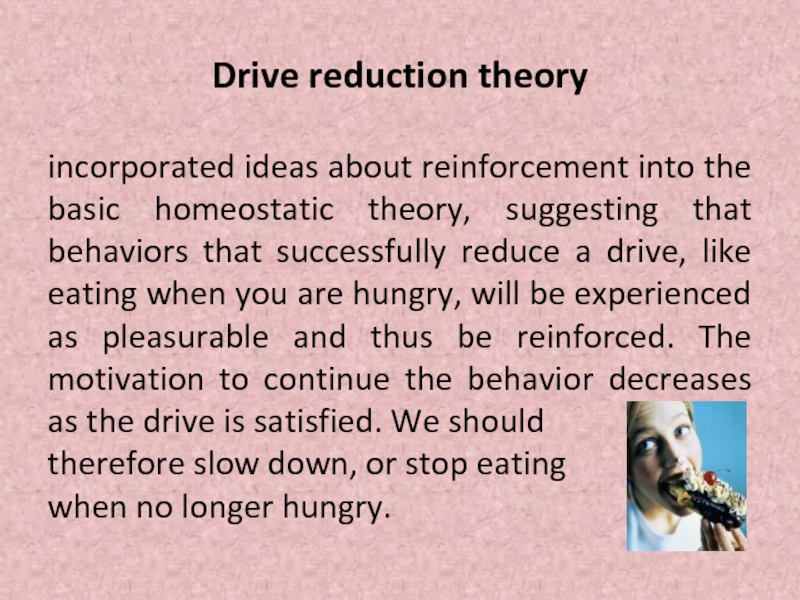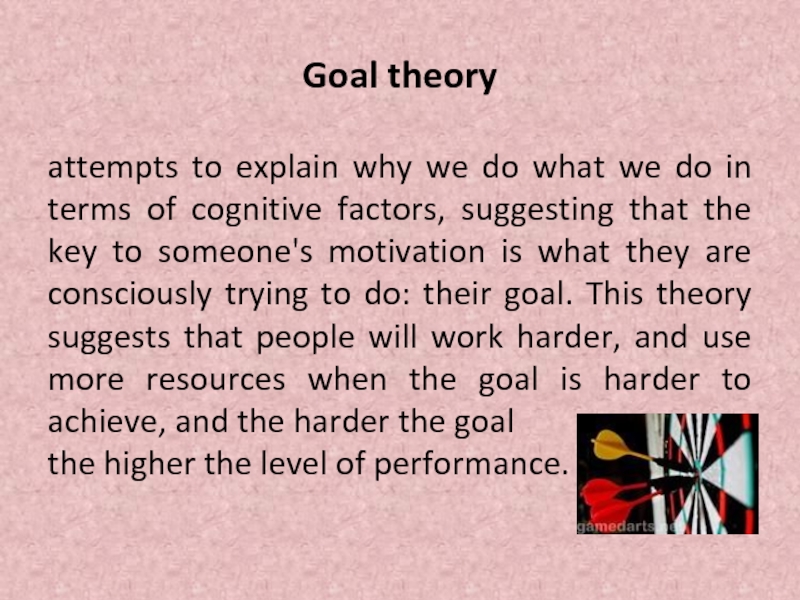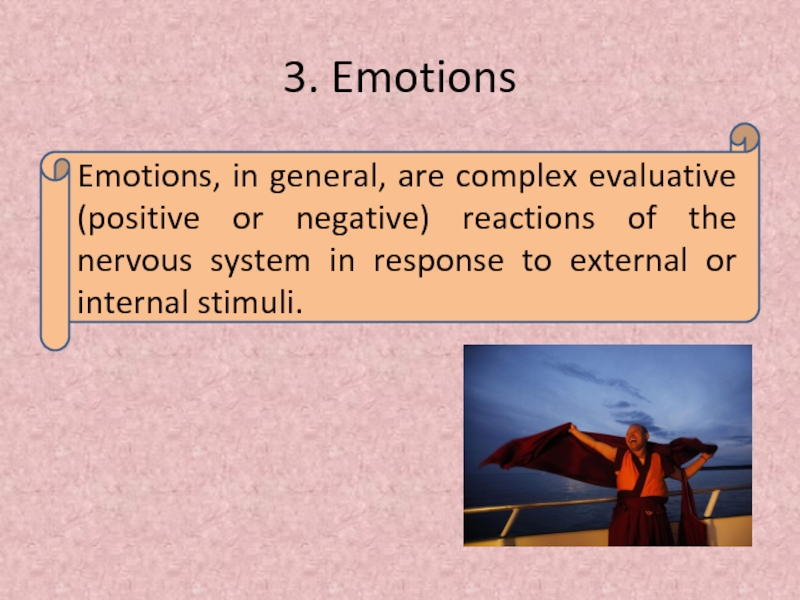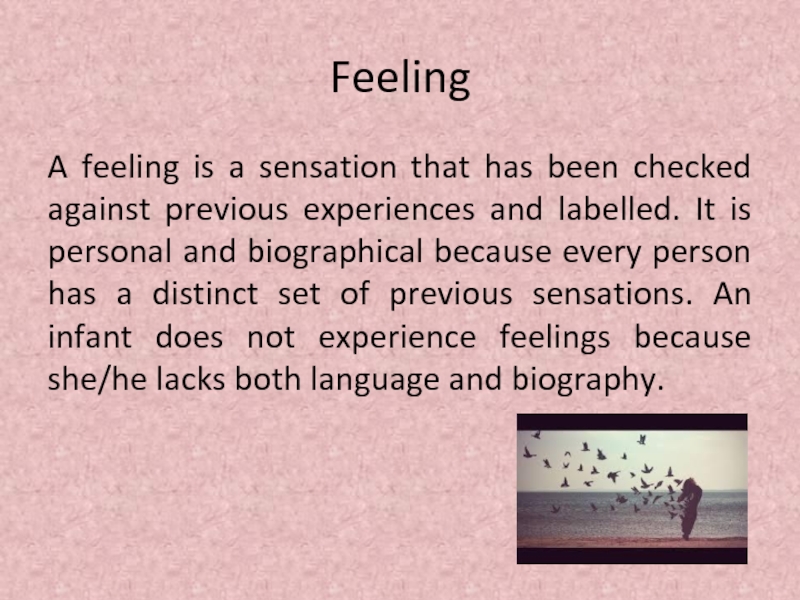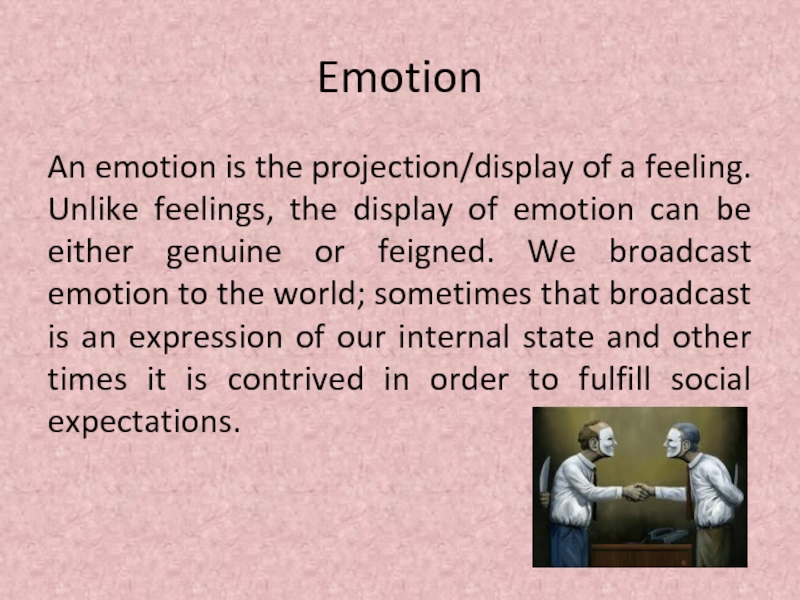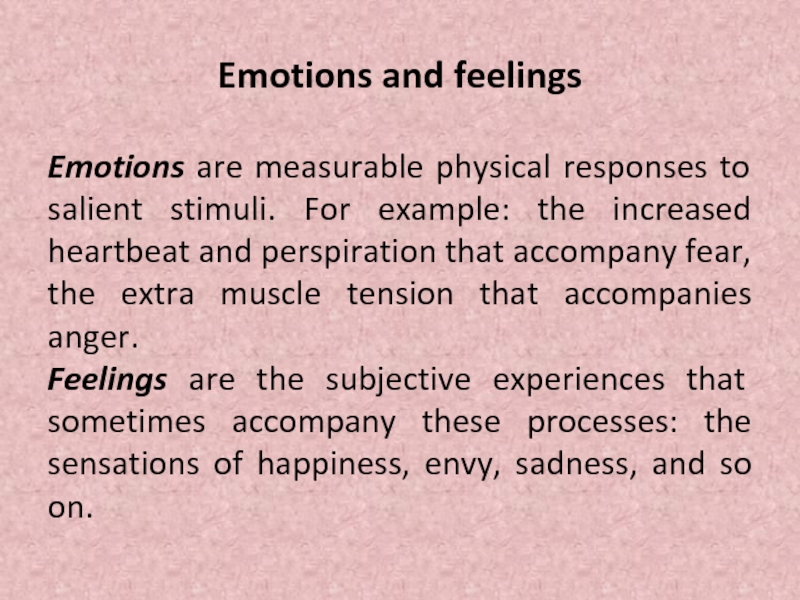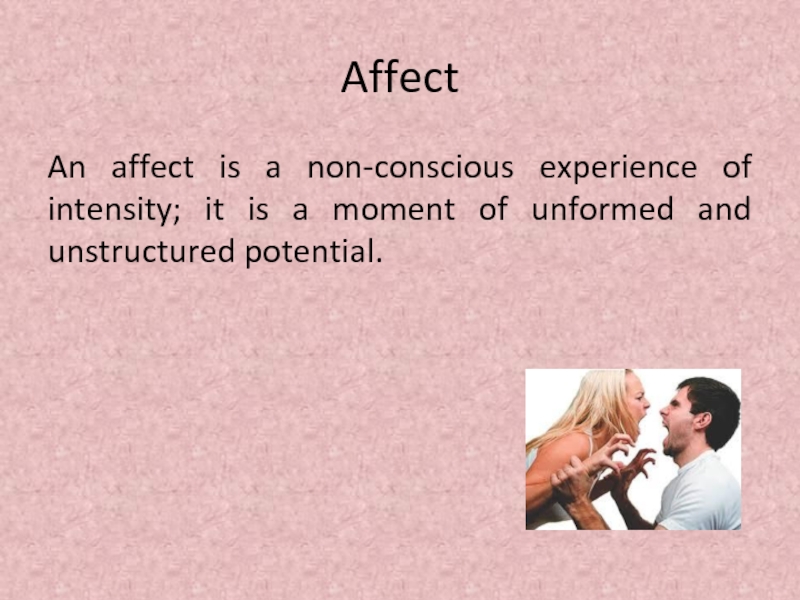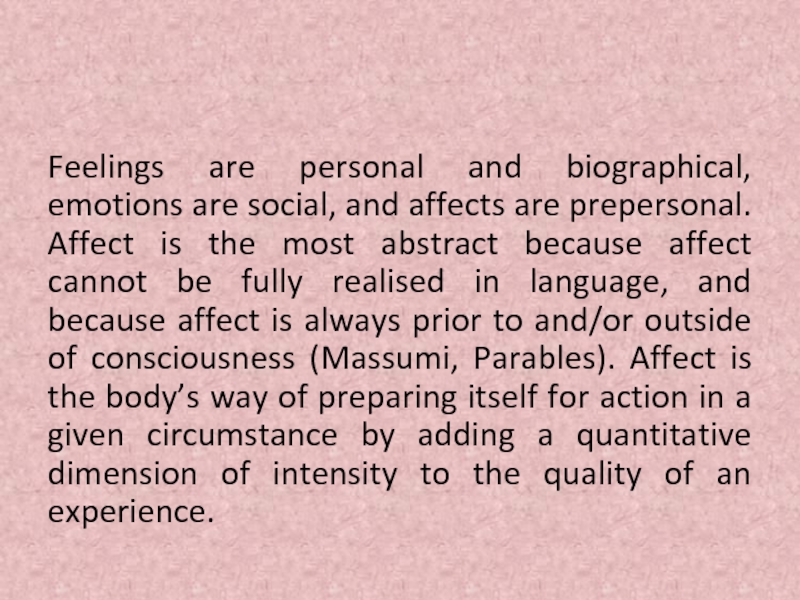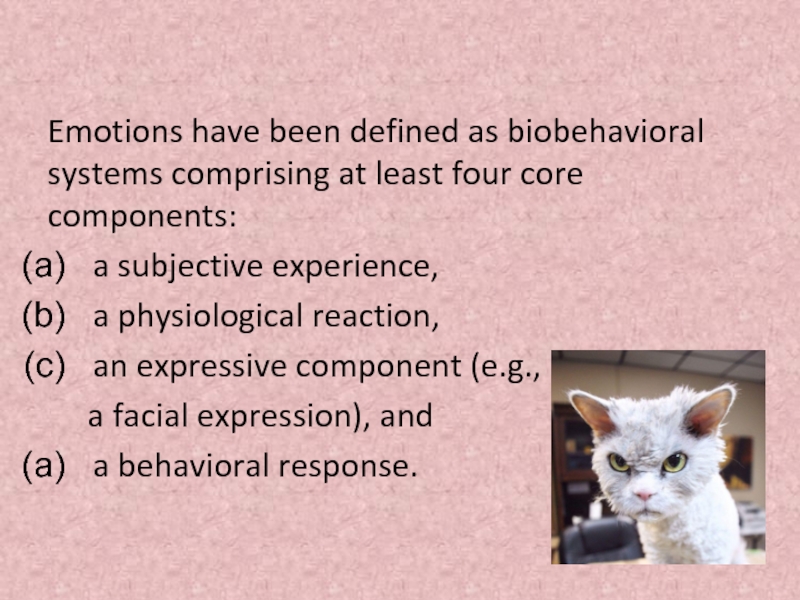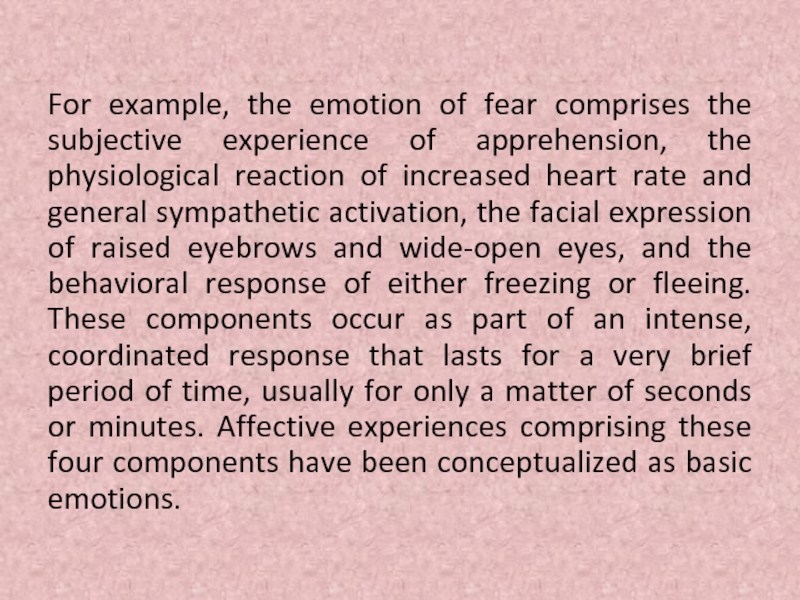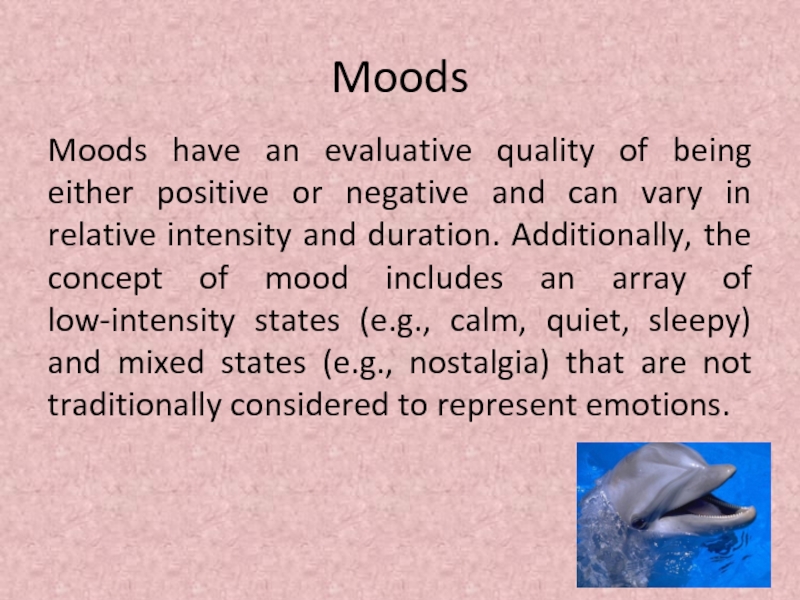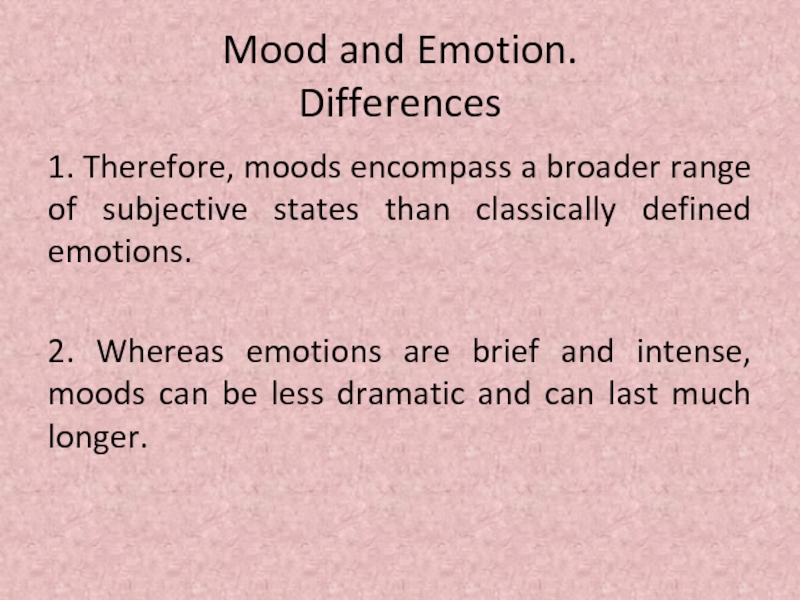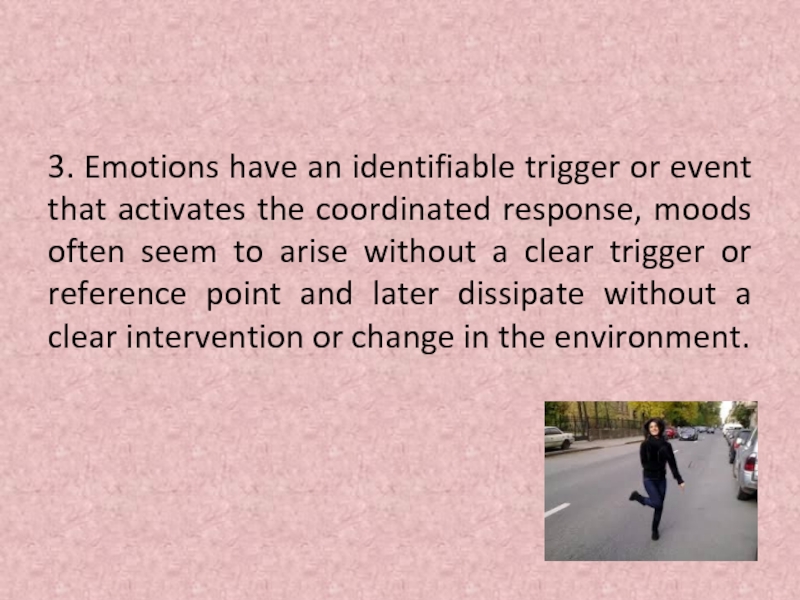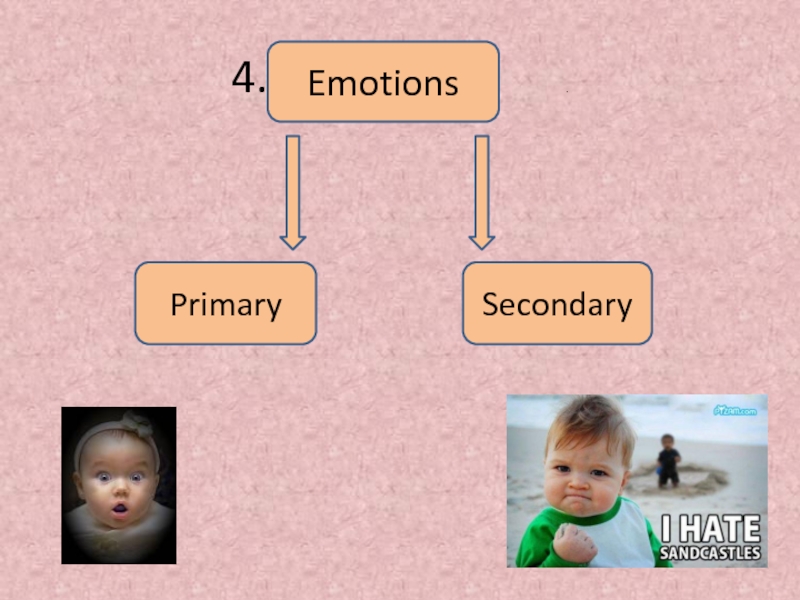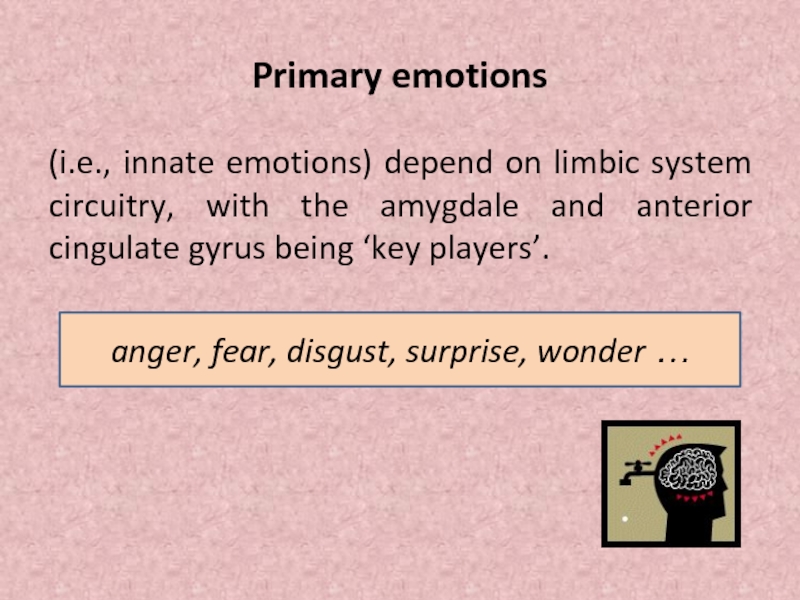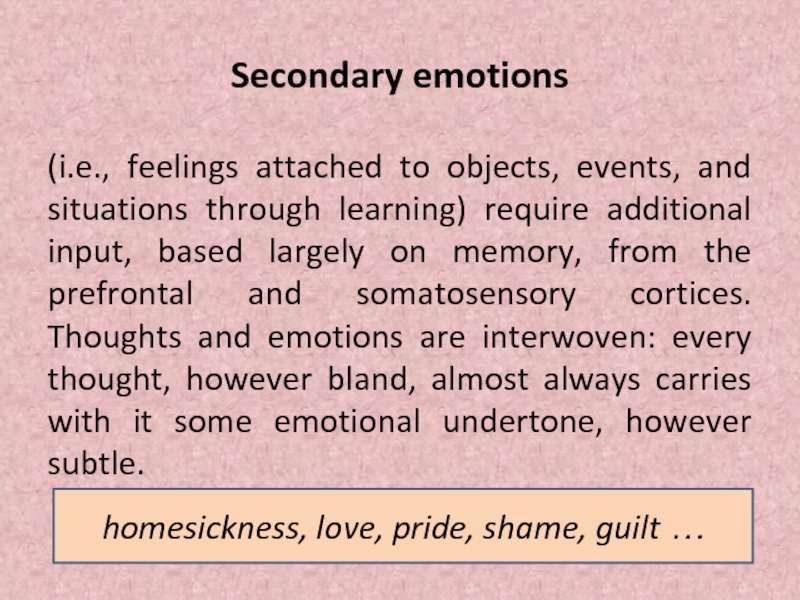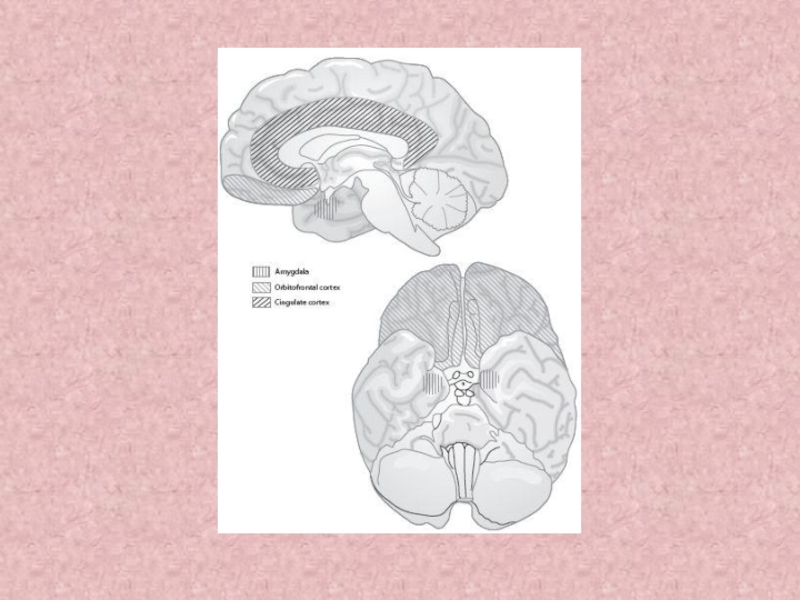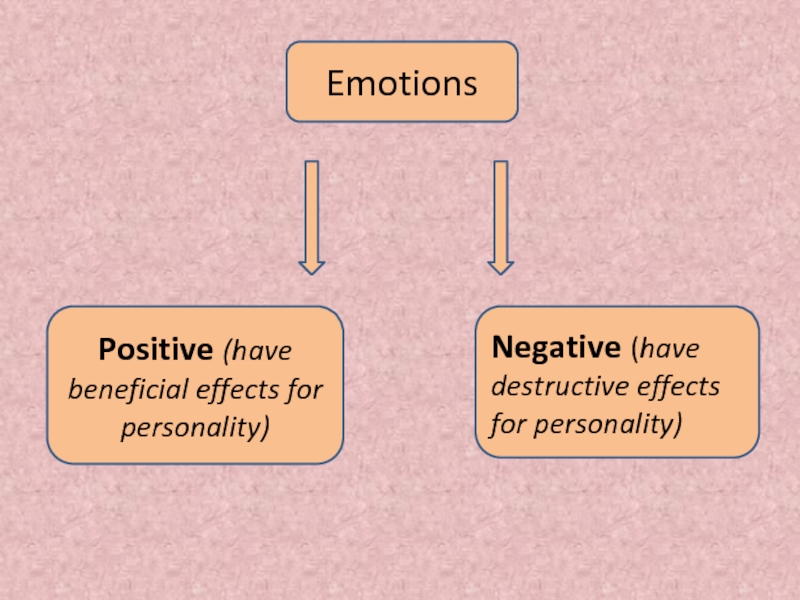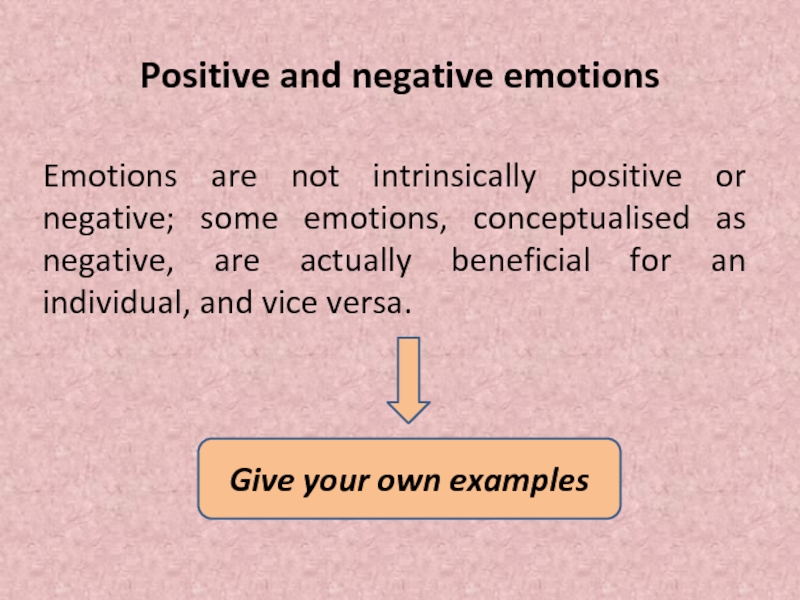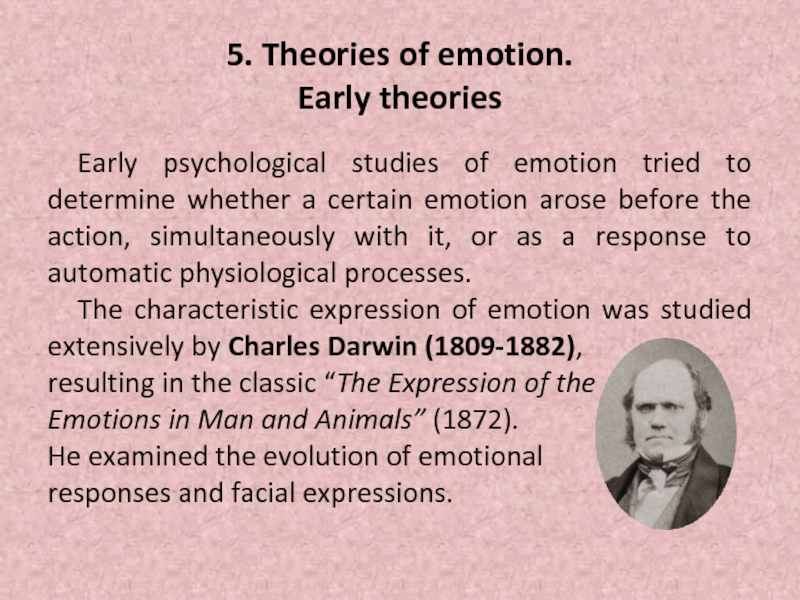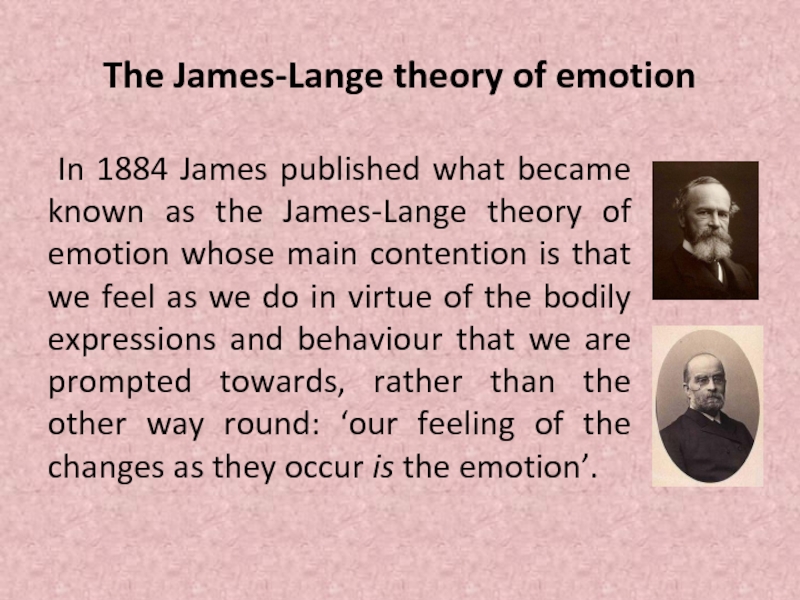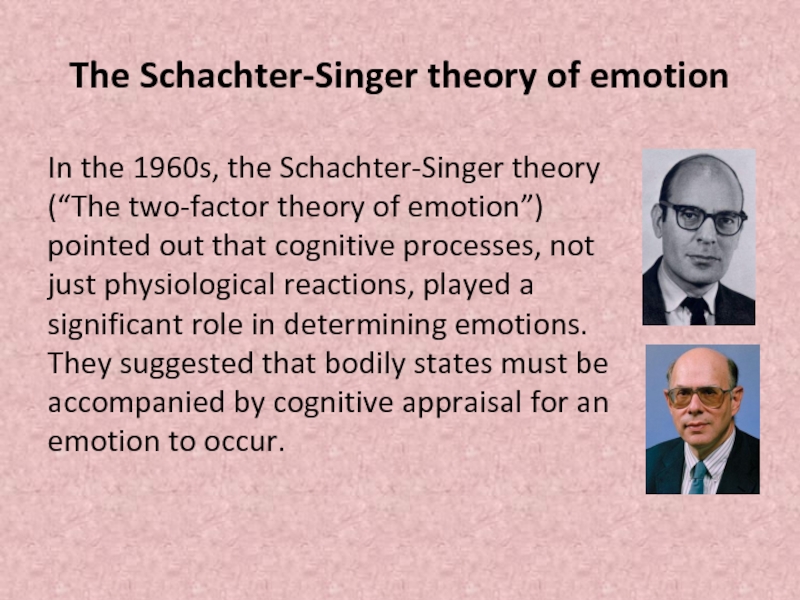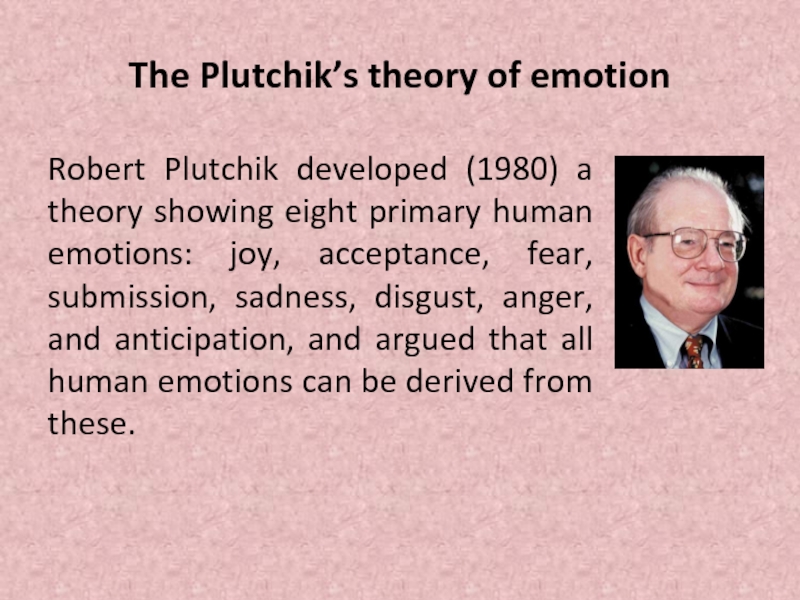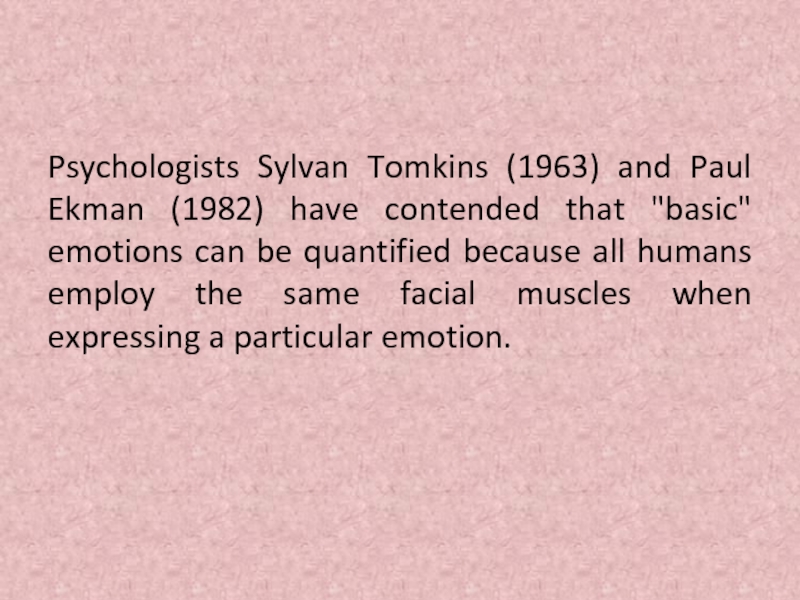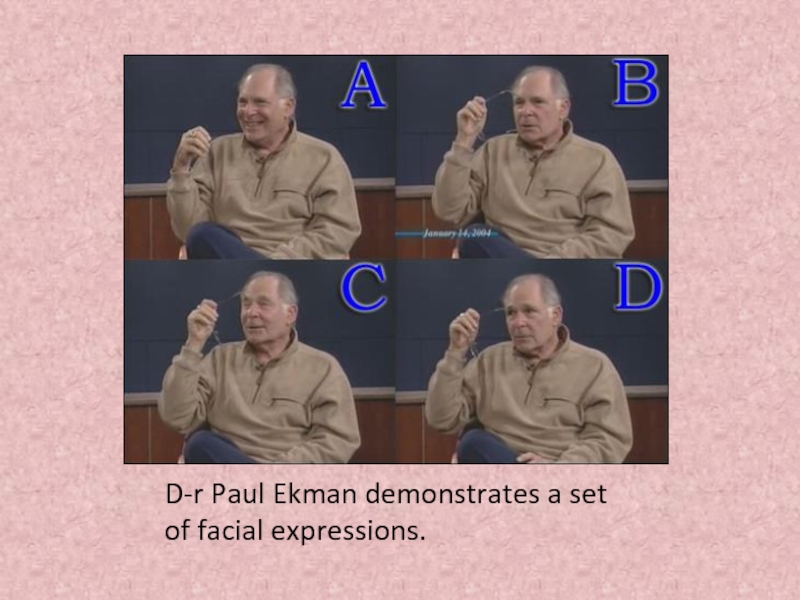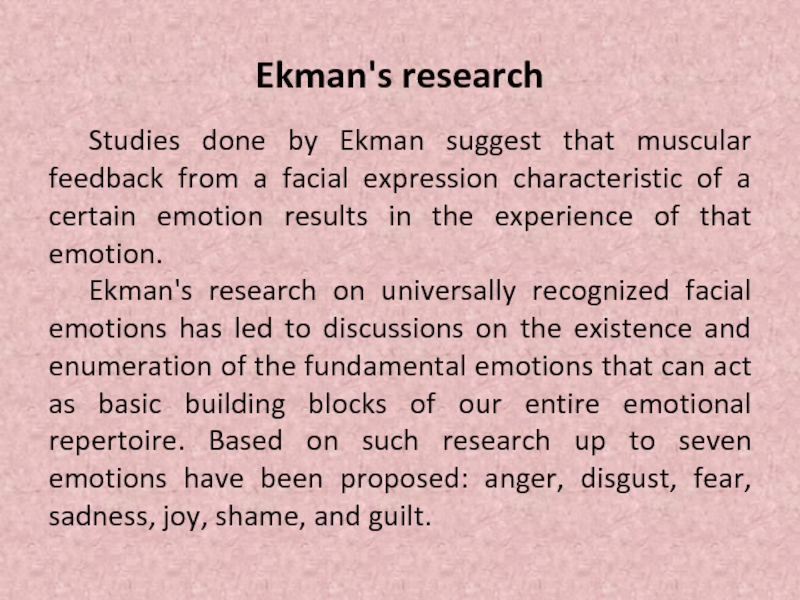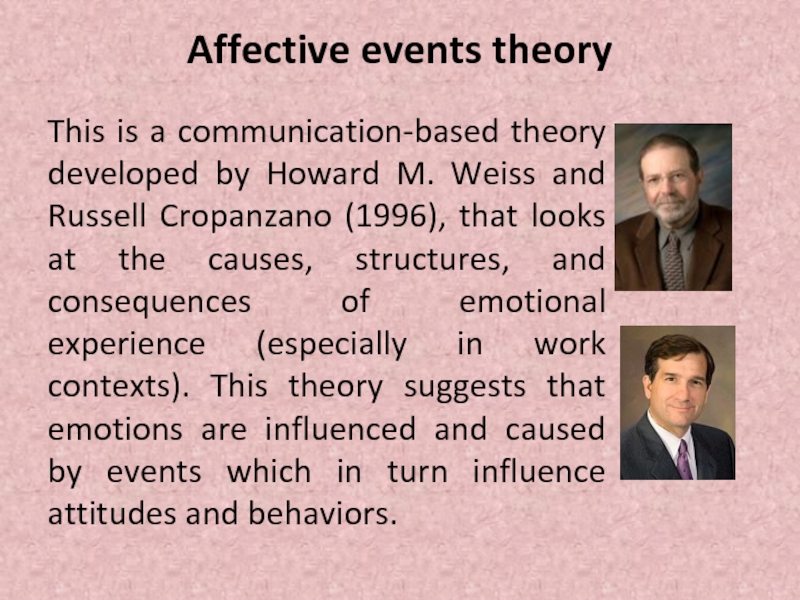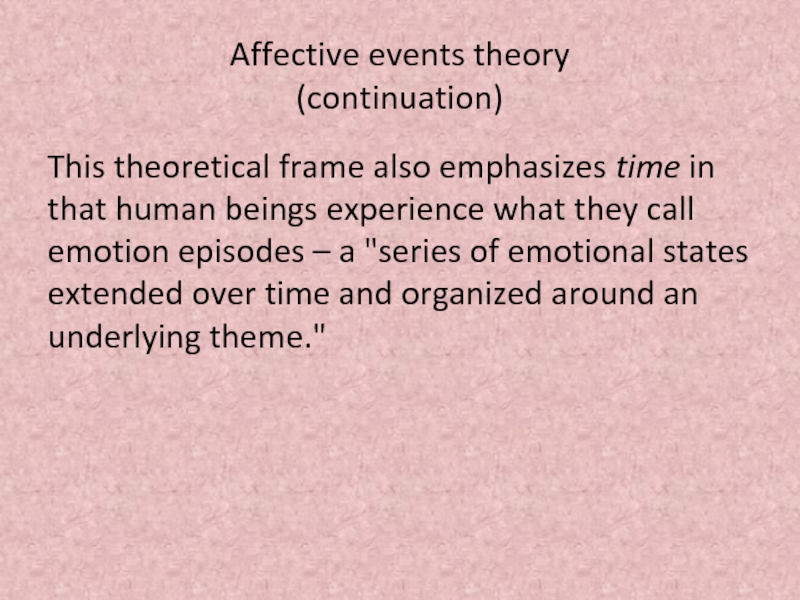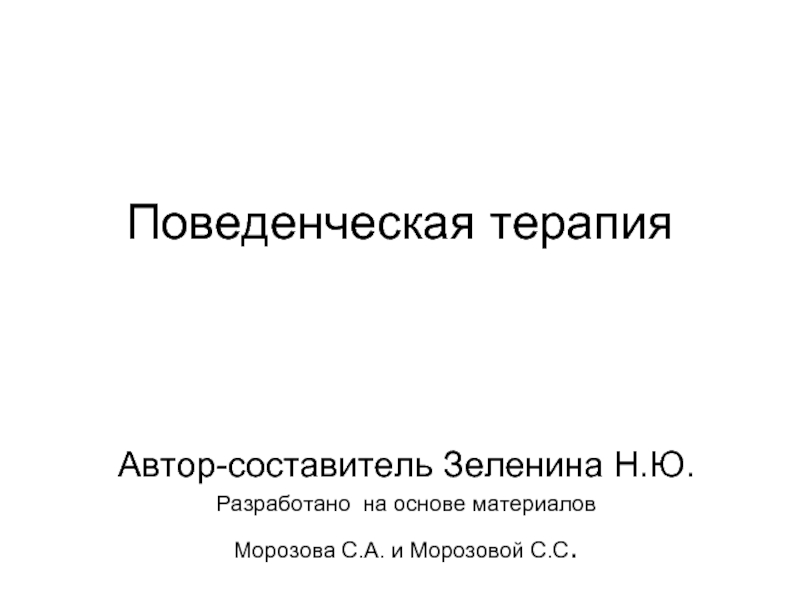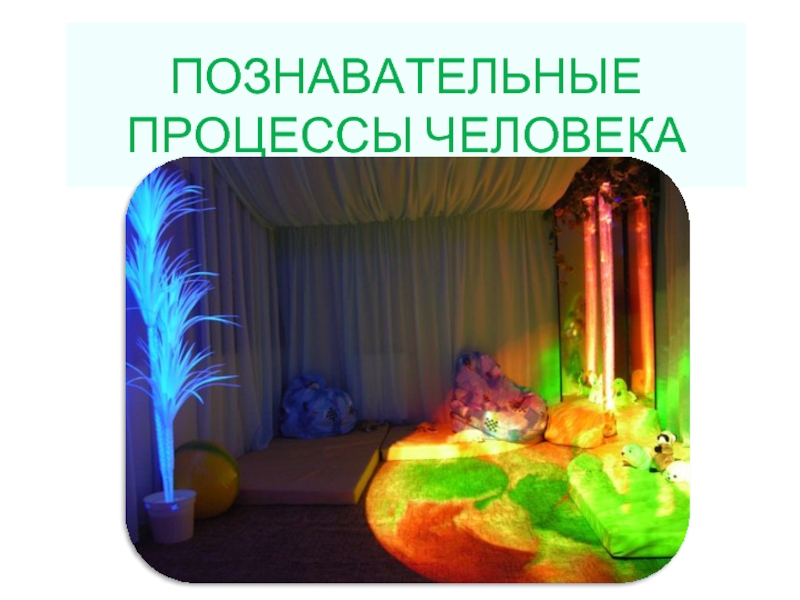- Главная
- Разное
- Дизайн
- Бизнес и предпринимательство
- Аналитика
- Образование
- Развлечения
- Красота и здоровье
- Финансы
- Государство
- Путешествия
- Спорт
- Недвижимость
- Армия
- Графика
- Культурология
- Еда и кулинария
- Лингвистика
- Английский язык
- Астрономия
- Алгебра
- Биология
- География
- Детские презентации
- Информатика
- История
- Литература
- Маркетинг
- Математика
- Медицина
- Менеджмент
- Музыка
- МХК
- Немецкий язык
- ОБЖ
- Обществознание
- Окружающий мир
- Педагогика
- Русский язык
- Технология
- Физика
- Философия
- Химия
- Шаблоны, картинки для презентаций
- Экология
- Экономика
- Юриспруденция
Motivation and emotions презентация
Содержание
- 1. Motivation and emotions
- 2. 1. Motivation Motivation is the conscious or
- 3. Motivation Intrinsic Extrinsic
- 4. Intrinsic motivation refers to motivation that is
- 5. Extrinsic motivation refers to the performance of
- 6. Motive - a reason for
- 7. Primary motives help us to satisfy basic
- 8. Secondary motives (such as friendship or freedom)
- 9. 2. The main theories of motivation
- 10. Maslow’s theory of motivation (continuation) Maslow
- 11. Hierarchy of needs (Maslow’s pyramid)
- 12. Homeostatic drive theory The basic idea in
- 13. Drive reduction theory incorporated ideas about reinforcement
- 14. Goal theory attempts to explain why we
- 15. 3. Emotions Emotions, in general, are complex
- 16. Feeling A feeling is a sensation that
- 17. Emotion An emotion is the projection/display of
- 18. Emotions and feelings Emotions are measurable physical
- 19. Affect An affect is a non-conscious experience
- 20. Feelings are personal and biographical, emotions
- 21. Emotions have been defined as biobehavioral
- 22. For example, the emotion of fear
- 23. Moods Moods have an evaluative quality of
- 24. Mood and Emotion. Differences 1. Therefore, moods
- 25. 3. Emotions have an identifiable trigger
- 26. 4.
- 27. Primary emotions (i.e., innate emotions) depend on
- 28. Secondary emotions (i.e., feelings attached to objects,
- 30. Emotions Positive (have
- 31. Positive and negative emotions Emotions are not
- 32. 5. Theories of emotion. Early theories Early
- 33. The James-Lange theory of emotion In
- 34. The Schachter-Singer theory of emotion In the
- 35. The Plutchik’s theory of emotion Robert Plutchik
- 36. Plutchik's Wheel of Emotions
- 37. Psychologists Sylvan Tomkins (1963) and Paul
- 38. D-r Paul Ekman demonstrates a set of facial expressions.
- 39. Ekman's research Studies done by Ekman suggest
- 40. Affective events theory This is a
- 41. Affective events theory (continuation) This theoretical frame
Слайд 1MOTIVATION AND EMOTIONS
Motivation. Primary and secondary motives.
The main theories of motivation.
Definitions
of emotion, feeling, affect, mood.
Classification of emotions.
Theories of emotion.
Classification of emotions.
Theories of emotion.
Слайд 21. Motivation
Motivation is the conscious or unconscious stimulus for action towards
a desired goal provided by psychological or social factors; that which gives purpose or direction to behavior.
Слайд 4Intrinsic motivation
refers to motivation that is driven by an interest or
enjoyment in the task itself, and exists within the individual rather than relying on any external pressure. Intrinsic Motivation is based on taking pleasure in an activity rather working towards an external reward.
Слайд 5Extrinsic motivation
refers to the performance of an activity in order to
attain an outcome, which then contradicts intrinsic motivation. Extrinsic motivation comes from outside of the individual. Common extrinsic motivations are rewards like money and grades, coercion and threat of punishment.
Слайд 6
Motive - a reason for a certain course of action, whether
conscious or unconscious
Primary
Secondary
Слайд 7Primary motives
help us to satisfy basic needs, such as those for
food, drink, warmth, and shelter. These needs have to be satisfied to ensure survival and they do not respond readily to attempts to control them voluntarily - one reason why it is so hard to regulate. Some of them are cyclical (e.g eating and drinking) and the force with which they are felt increases and decreases in a more or less regular way.
Слайд 8Secondary motives
(such as friendship or freedom) are acquired or learned, and
the needs they satisfy may, or may not, be indirectly related to primary motives. Some secondary motives are easily recognized: the need for friendship, or for independence, or being nice to someone out of guilt. Others may be outside conscious awareness, such as those things that I do to enhance or
protect my self-esteem.
protect my self-esteem.
Слайд 92. The main theories of motivation
Maslow’s theory
Abraham Maslow (1908-1970)
in
1954 constructed
a hierarchy ranging from
lower level needs,
satisfying which reduces deficiencies in physiological systems (needs for food and water), to higher level personal or abstract needs.
a hierarchy ranging from
lower level needs,
satisfying which reduces deficiencies in physiological systems (needs for food and water), to higher level personal or abstract needs.
Слайд 10Maslow’s theory of motivation
(continuation)
Maslow believed that higher level needs will only
emerge when lower level needs are satisfied.
The value of this theory has mainly been in the impetus it provided to the development of humanistic types of therapy.
The value of this theory has mainly been in the impetus it provided to the development of humanistic types of therapy.
Слайд 12Homeostatic drive theory
The basic idea in this theory is that it
is important to maintain a reasonably constant internal environment. Any move away from this, or imbalance, prompts action to restore the balanced state. The action is 'driven' by the sense of imbalance, and
continues until the balance
is restored: hunger send us
to the kitchen.
continues until the balance
is restored: hunger send us
to the kitchen.
Слайд 13Drive reduction theory
incorporated ideas about reinforcement into the basic homeostatic theory,
suggesting that behaviors that successfully reduce a drive, like eating when you are hungry, will be experienced as pleasurable and thus be reinforced. The motivation to continue the behavior decreases as the drive is satisfied. We should
therefore slow down, or stop eating
when no longer hungry.
therefore slow down, or stop eating
when no longer hungry.
Слайд 14Goal theory
attempts to explain why we do what we do in
terms of cognitive factors, suggesting that the key to someone's motivation is what they are consciously trying to do: their goal. This theory suggests that people will work harder, and use more resources when the goal is harder to achieve, and the harder the goal
the higher the level of performance.
the higher the level of performance.
Слайд 153. Emotions
Emotions, in general, are complex evaluative (positive or negative) reactions
of the nervous system in response to external or internal stimuli.
Слайд 16Feeling
A feeling is a sensation that has been checked against previous
experiences and labelled. It is personal and biographical because every person has a distinct set of previous sensations. An infant does not experience feelings because she/he lacks both language and biography.
Слайд 17Emotion
An emotion is the projection/display of a feeling. Unlike feelings, the
display of emotion can be either genuine or feigned. We broadcast emotion to the world; sometimes that broadcast is an expression of our internal state and other times it is contrived in order to fulfill social expectations.
Слайд 18Emotions and feelings
Emotions are measurable physical responses to salient stimuli. For
example: the increased heartbeat and perspiration that accompany fear, the extra muscle tension that accompanies anger.
Feelings are the subjective experiences that sometimes accompany these processes: the sensations of happiness, envy, sadness, and so on.
Feelings are the subjective experiences that sometimes accompany these processes: the sensations of happiness, envy, sadness, and so on.
Слайд 19Affect
An affect is a non-conscious experience of intensity; it is a
moment of unformed and unstructured potential.
Слайд 20
Feelings are personal and biographical, emotions are social, and affects are
prepersonal. Affect is the most abstract because affect cannot be fully realised in language, and because affect is always prior to and/or outside of consciousness (Massumi, Parables). Affect is the body’s way of preparing itself for action in a given circumstance by adding a quantitative dimension of intensity to the quality of an experience.
Слайд 21
Emotions have been defined as biobehavioral systems comprising at least four
core components:
a subjective experience,
a physiological reaction,
an expressive component (e.g.,
a facial expression), and
a behavioral response.
a subjective experience,
a physiological reaction,
an expressive component (e.g.,
a facial expression), and
a behavioral response.
Слайд 22
For example, the emotion of fear comprises the subjective experience of
apprehension, the physiological reaction of increased heart rate and general sympathetic activation, the facial expression of raised eyebrows and wide-open eyes, and the behavioral response of either freezing or fleeing. These components occur as part of an intense, coordinated response that lasts for a very brief period of time, usually for only a matter of seconds or minutes. Affective experiences comprising these four components have been conceptualized as basic emotions.
Слайд 23Moods
Moods have an evaluative quality of being either positive or negative
and can vary in relative intensity and duration. Additionally, the concept of mood includes an array of low-intensity states (e.g., calm, quiet, sleepy) and mixed states (e.g., nostalgia) that are not traditionally considered to represent emotions.
Слайд 24Mood and Emotion.
Differences
1. Therefore, moods encompass a broader range of subjective
states than classically defined emotions.
2. Whereas emotions are brief and intense, moods can be less dramatic and can last much longer.
2. Whereas emotions are brief and intense, moods can be less dramatic and can last much longer.
Слайд 25
3. Emotions have an identifiable trigger or event that activates the
coordinated response, moods often seem to arise without a clear trigger or reference point and later dissipate without a clear intervention or change in the environment.
Слайд 27Primary emotions
(i.e., innate emotions) depend on limbic system circuitry, with the
amygdale and anterior cingulate gyrus being ‘key players’.
anger, fear, disgust, surprise, wonder …
Слайд 28Secondary emotions
(i.e., feelings attached to objects, events, and situations through learning)
require additional input, based largely on memory, from the prefrontal and somatosensory cortices. Thoughts and emotions are interwoven: every thought, however bland, almost always carries with it some emotional undertone, however subtle.
homesickness, love, pride, shame, guilt …
Слайд 30
Emotions
Positive (have beneficial effects for personality)
Negative (have destructive effects for personality)
Слайд 31Positive and negative emotions
Emotions are not intrinsically positive or negative; some
emotions, conceptualised as negative, are actually beneficial for an individual, and vice versa.
Give your own examples
Слайд 325. Theories of emotion.
Early theories
Early psychological studies of emotion tried to
determine whether a certain emotion arose before the action, simultaneously with it, or as a response to automatic physiological processes.
The characteristic expression of emotion was studied extensively by Charles Darwin (1809-1882),
resulting in the classic “The Expression of the
Emotions in Man and Animals” (1872).
He examined the evolution of emotional
responses and facial expressions.
The characteristic expression of emotion was studied extensively by Charles Darwin (1809-1882),
resulting in the classic “The Expression of the
Emotions in Man and Animals” (1872).
He examined the evolution of emotional
responses and facial expressions.
Слайд 33The James-Lange theory of emotion
In 1884 James published what became
known as the James-Lange theory of emotion whose main contention is that we feel as we do in virtue of the bodily expressions and behaviour that we are prompted towards, rather than the other way round: ‘our feeling of the changes as they occur is the emotion’.
Слайд 34The Schachter-Singer theory of emotion
In the 1960s, the Schachter-Singer theory (“The
two-factor theory of emotion”) pointed out that cognitive processes, not just physiological reactions, played a significant role in determining emotions.
They suggested that bodily states must be accompanied by cognitive appraisal for an emotion to occur.
They suggested that bodily states must be accompanied by cognitive appraisal for an emotion to occur.
Слайд 35The Plutchik’s theory of emotion
Robert Plutchik developed (1980) a theory showing
eight primary human emotions: joy, acceptance, fear, submission, sadness, disgust, anger, and anticipation, and argued that all human emotions can be derived from these.
Слайд 37
Psychologists Sylvan Tomkins (1963) and Paul Ekman (1982) have contended that
"basic" emotions can be quantified because all humans employ the same facial muscles when expressing a particular emotion.
Слайд 39Ekman's research
Studies done by Ekman suggest that muscular feedback from a
facial expression characteristic of a certain emotion results in the experience of that emotion.
Ekman's research on universally recognized facial emotions has led to discussions on the existence and enumeration of the fundamental emotions that can act as basic building blocks of our entire emotional repertoire. Based on such research up to seven emotions have been proposed: anger, disgust, fear, sadness, joy, shame, and guilt.
Ekman's research on universally recognized facial emotions has led to discussions on the existence and enumeration of the fundamental emotions that can act as basic building blocks of our entire emotional repertoire. Based on such research up to seven emotions have been proposed: anger, disgust, fear, sadness, joy, shame, and guilt.
Слайд 40Affective events theory
This is a communication-based theory developed by Howard M.
Weiss and Russell Cropanzano (1996), that looks at the causes, structures, and consequences of emotional experience (especially in work contexts). This theory suggests that emotions are influenced and caused by events which in turn influence attitudes and behaviors.
Слайд 41Affective events theory
(continuation)
This theoretical frame also emphasizes time in that human
beings experience what they call emotion episodes – a "series of emotional states extended over time and organized around an underlying theme."
